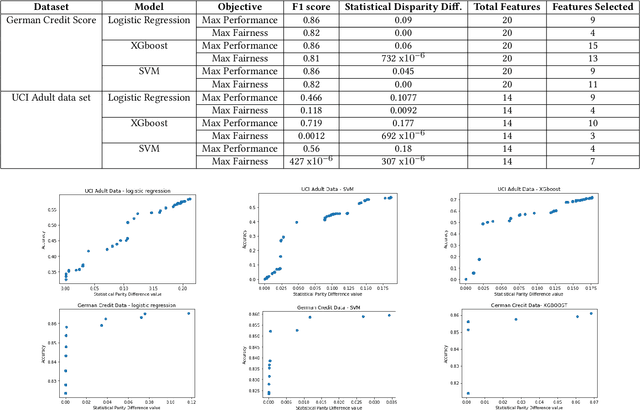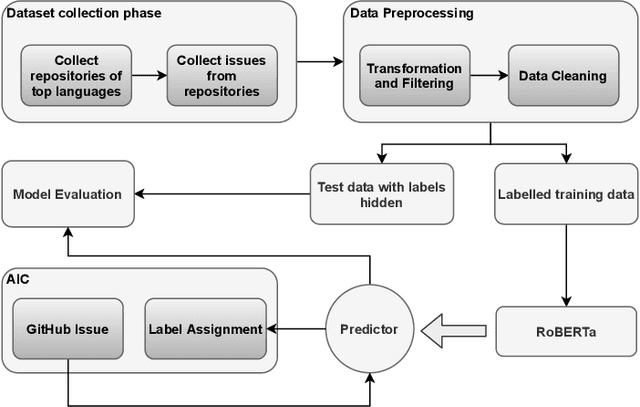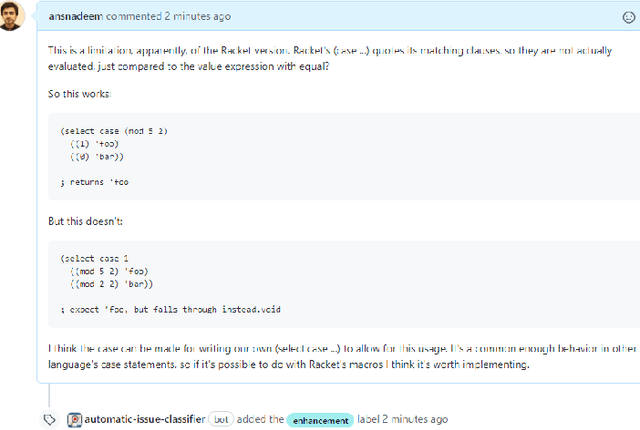Anas Nadeem
MaintainoMATE: A GitHub App for Intelligent Automation of Maintenance Activities
Aug 31, 2023Abstract:Software development projects rely on issue tracking systems at the core of tracking maintenance tasks such as bug reports, and enhancement requests. Incoming issue-reports on these issue tracking systems must be managed in an effective manner. First, they must be labelled and then assigned to a particular developer with relevant expertise. This handling of issue-reports is critical and requires thorough scanning of the text entered in an issue-report making it a labor-intensive task. In this paper, we present a unified framework called MaintainoMATE, which is capable of automatically categorizing the issue-reports in their respective category and further assigning the issue-reports to a developer with relevant expertise. We use the Bidirectional Encoder Representations from Transformers (BERT), as an underlying model for MaintainoMATE to learn the contextual information for automatic issue-report labeling and assignment tasks. We deploy the framework used in this work as a GitHub application. We empirically evaluate our approach on GitHub issue-reports to show its capability of assigning labels to the issue-reports. We were able to achieve an F1-score close to 80\%, which is comparable to existing state-of-the-art results. Similarly, our initial evaluations show that we can assign relevant developers to the issue-reports with an F1 score of 54\%, which is a significant improvement over existing approaches. Our initial findings suggest that MaintainoMATE has the potential of improving software quality and reducing maintenance costs by accurately automating activities involved in the maintenance processes. Our future work would be directed towards improving the issue-assignment module.
Fair Feature Subset Selection using Multiobjective Genetic Algorithm
Apr 30, 2022

Abstract:The feature subset selection problem aims at selecting the relevant subset of features to improve the performance of a Machine Learning (ML) algorithm on training data. Some features in data can be inherently noisy, costly to compute, improperly scaled, or correlated to other features, and they can adversely affect the accuracy, cost, and complexity of the induced algorithm. The goal of traditional feature selection approaches has been to remove such irrelevant features. In recent years ML is making a noticeable impact on the decision-making processes of our everyday lives. We want to ensure that these decisions do not reflect biased behavior towards certain groups or individuals based on protected attributes such as age, sex, or race. In this paper, we present a feature subset selection approach that improves both fairness and accuracy objectives and computes Pareto-optimal solutions using the NSGA-II algorithm. We use statistical disparity as a fairness metric and F1-Score as a metric for model performance. Our experiments on the most commonly used fairness benchmark datasets with three different machine learning algorithms show that using the evolutionary algorithm we can effectively explore the trade-off between fairness and accuracy.
Automatic Issue Classifier: A Transfer Learning Framework for Classifying Issue Reports
Feb 12, 2022



Abstract:Issue tracking systems are used in the software industry for the facilitation of maintenance activities that keep the software robust and up to date with ever-changing industry requirements. Usually, users report issues that can be categorized into different labels such as bug reports, enhancement requests, and questions related to the software. Most of the issue tracking systems make the labelling of these issue reports optional for the issue submitter, which leads to a large number of unlabeled issue reports. In this paper, we present a state-of-the-art method to classify the issue reports into their respective categories i.e. bug, enhancement, and question. This is a challenging task because of the common use of informal language in the issue reports. Existing studies use traditional natural language processing approaches adopting key-word based features, which fail to incorporate the contextual relationship between words and therefore result in a high rate of false positives and false negatives. Moreover, previous works utilize a uni-label approach to classify the issue reports however, in reality, an issue-submitter can tag one issue report with more than one label at a time. This paper presents our approach to classify the issue reports in a multi-label setting. We use an off-the-shelf neural network called RoBERTa and fine-tune it to classify the issue reports. We validate our approach on issue reports belonging to numerous industrial projects from GitHub. We were able to achieve promising F-1 scores of 81%, 74%, and 80% for bug reports, enhancements, and questions, respectively. We also develop an industry tool called Automatic Issue Classifier (AIC), which automatically assigns labels to newly reported issues on GitHub repositories with high accuracy.
 Add to Chrome
Add to Chrome Add to Firefox
Add to Firefox Add to Edge
Add to Edge